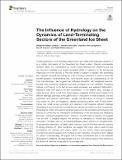Files in this item
The influence of hydrology on the dynamics of land-terminating sectors of the Greenland Ice Sheet
Item metadata
| dc.contributor.author | Davison, Ben | |
| dc.contributor.author | Sole, Andrew | |
| dc.contributor.author | Livingstone, Stephen | |
| dc.contributor.author | Cowton, Tom | |
| dc.contributor.author | Nienow, Peter | |
| dc.date.accessioned | 2019-02-21T12:30:05Z | |
| dc.date.available | 2019-02-21T12:30:05Z | |
| dc.date.issued | 2019-02-21 | |
| dc.identifier | 257677823 | |
| dc.identifier | 1f679825-a690-418f-843b-c8378f8a7465 | |
| dc.identifier | 85064147222 | |
| dc.identifier | 000467221000001 | |
| dc.identifier.citation | Davison , B , Sole , A , Livingstone , S , Cowton , T & Nienow , P 2019 , ' The influence of hydrology on the dynamics of land-terminating sectors of the Greenland Ice Sheet ' , Frontiers in Earth Sciences , vol. 7 , 10 . https://doi.org/10.3389/feart.2019.00010 | en |
| dc.identifier.issn | 1863-4621 | |
| dc.identifier.uri | https://hdl.handle.net/10023/17121 | |
| dc.description | Funding: The Scottish Alliance for Geoscience, Environment and Society (SAGES) provided financial support for this work in the form of a studentship for BJD. | en |
| dc.description.abstract | Coupling between runoff, hydrology, basal motion and mass loss (‘hydrology-dynamics’) is a critical component of the Greenland Ice Sheet system. Despite considerable research effort, the mechanisms by which runoff influences ice dynamics and the net long-term (decadal and longer) dynamical effect of variations in the timing and magnitude of runoff delivery to the bed remain a subject of debate. We synthesise key research into land-terminating ice sheet hydrology-dynamics, in order to reconcile several apparent contradictions that have recently arisen as understanding of the topic has developed. We suggest that meltwater interaction with subglacial channels, cavities and deforming subglacial sediment modulates ice flow variability. Increasing surface runoff supply to the bed induces cavity expansion and sediment deformation, leading to early-melt season ice flow acceleration. In the ablation area, drainage of water at times of low runoff from high-pressure subglacial environments towards more efficient drainage pathways is thought to result in reductions in water pressure, ice-bed separation and sediment deformation, causing net slow-down on annual to decadal time-scales (ice flow self-regulation), despite increasing surface melt. Further inland, thicker ice, small surface gradients and reduced runoff supress efficient drainage development, and a small net increase in both summer and winter ice flow is observed. Predicting ice motion across land-terminating sectors of the ice sheet over the 21st century is confounded by inadequate understanding of the processes and feedbacks between runoff and subglacial motion. However, if runoff supply increases, we suggest that ice flow in marginal regions will continue to decrease on annual and longer timescales, principally due to (i) increasing drainage system efficiency in marginal areas, (ii) progressive depression of basal water pressure and (iii) thinning-induced lowering of driving stresses. At higher elevations, we suggest that minor year-on-year ice flow acceleration will continue and extend further into the interior where self-regulation mechanisms cannot operate and if surface-to-bed meltwater connections form. Based on current understanding, we expect that ice flow deceleration due to the seasonal development of efficient drainage beneath the land-terminating margins of the Greenland Ice Sheet will continue to regulate its future mass loss. | |
| dc.format.extent | 24 | |
| dc.format.extent | 4004792 | |
| dc.language.iso | eng | |
| dc.relation.ispartof | Frontiers in Earth Sciences | en |
| dc.subject | Subglacial hydrology | en |
| dc.subject | Ice dynamics | en |
| dc.subject | Land-terminating | en |
| dc.subject | Supraglacial lakes | en |
| dc.subject | Greenland ice sheet | en |
| dc.subject | Glaciers | en |
| dc.subject | G Geography (General) | en |
| dc.subject | T-NDAS | en |
| dc.subject.lcc | G1 | en |
| dc.title | The influence of hydrology on the dynamics of land-terminating sectors of the Greenland Ice Sheet | en |
| dc.type | Journal item | en |
| dc.contributor.institution | University of St Andrews. School of Geography & Sustainable Development | en |
| dc.contributor.institution | University of St Andrews. Bell-Edwards Geographic Data Institute | en |
| dc.identifier.doi | 10.3389/feart.2019.00010 | |
| dc.description.status | Peer reviewed | en |
This item appears in the following Collection(s)
Items in the St Andrews Research Repository are protected by copyright, with all rights reserved, unless otherwise indicated.

